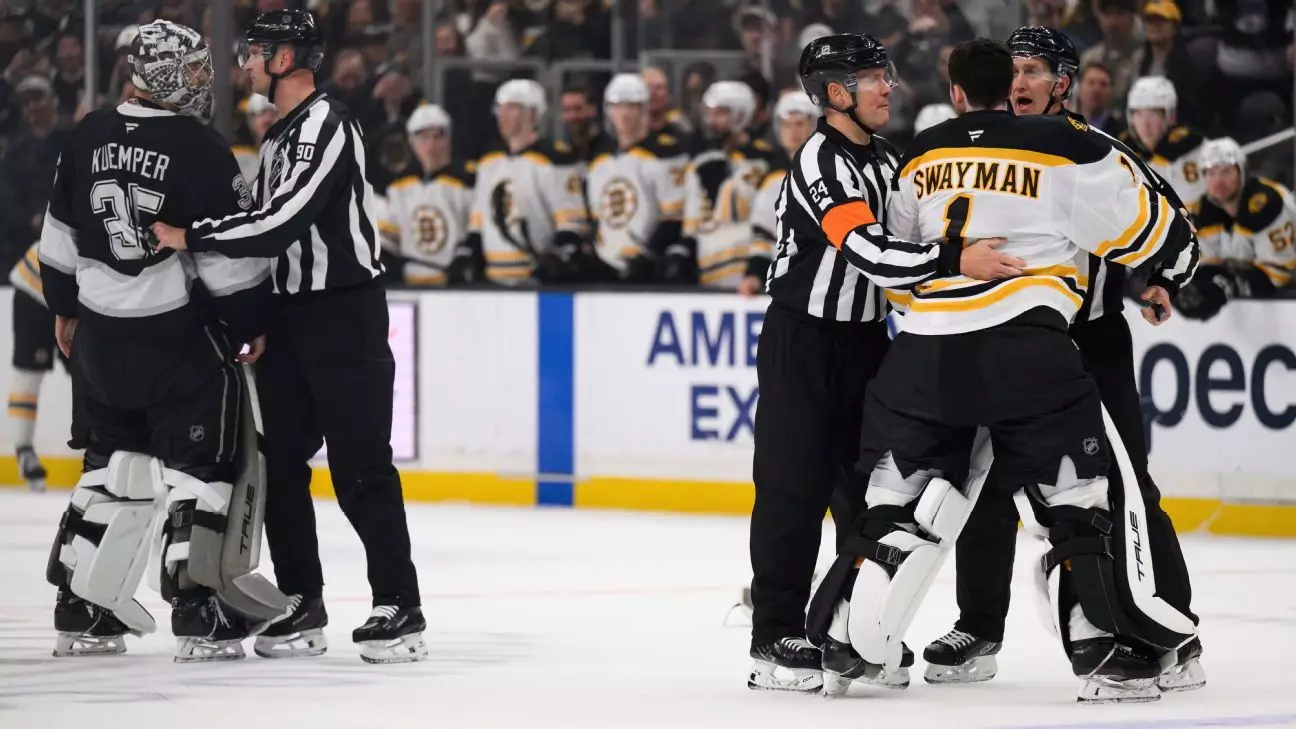In a sport where intensity meets passion, the recent encounter between Los Angeles Kings goalie Darcy Kuemper and Boston Bruins’ Jeremy Swayman showcases the electric moments that fuel the NHL. During a spirited clash, Kuemper skated to center ice, ready to engage in what many fans consider the ultimate showdown: a goalie fight. This dramatic buildup unfolded against the backdrop of a 7-2 blowout win by the Kings, an evening that highlighted not only the prowess of the team but also the tensions simmering beneath the surface.
Coach Jim Hiller’s reaction encapsulated the precarious nature of such moments. Although the possibility of seeing two star goaltenders engage head-to-head is tantalizing for fans, it raises significant concerns for coaches managing their players’ health and safety. The physicality of hockey is part of its allure, yet when the central protectors of the net meet in a potentially dangerous confrontation, the stakes become much higher. Hiller’s relief at Kumper and Swayman being restrained reflects a common, albeit understated, fear among coaches: risking injury to pivotal players can dramatically derail a season.
The Catalyst: A Series of Events
The sequence leading up to the near-fight is a classic illustration of how incidents can rapidly escalate in hockey. When Bruins forward Marat Khusnutdinov collided with Kuemper, a wave of protective instinct surged through Swayman. The aggression from Khusnutdinov put Kuemper in a vulnerable position, prompting him to retaliate with a fierce grip on the Boston player’s helmet. The ensuing penalties—on both goaltenders for leaving their crease—highlighted the chaotic ebb and flow of the game.
Such confrontations are not merely spur-of-the-moment decisions; they echo a culture deeply entrenched in the sport. Players are conditioned to protect their teammates, a fact that Swayman acknowledged when he stated, “He touched one of my guys, and I think that was something I’m not going to accept.” This sentiment reinforces the importance of camaraderie among players, even amidst fierce competition. Yet, does this ever-growing dedication to protecting each other sometimes teeter into the realm of recklessness—especially for a goalie, whose role naturally subjects him to unique vulnerabilities?
The Ghost of Goalie Fights Past
Keeping the audience on their toes, the past several years have seen goalies itching for barnburner moments without much resolution. The last real goalie fight occurred pre-pandemic, making the expectations for today’s enforcers even more poignant. Instances like Swayman’s failed entreaty for a fight against Toronto’s Joseph Woll exhibit a thirst for the return of the classic goalie duel, but often reflect a changing dynamic within the sport.
Referees have stepped in to defuse situations where goaltenders display a willingness to engage, a move that many see as a protective measure. While fan interest in goaltender skirmishes remains high, officials are very much aware of the physical limitations that come with a position that already samples danger on a nightly basis.
The Impact of Strategy on Player Safety
Hiller’s insights about players’ agility juxtaposed with the natural limitations of goalies accentuate an often overlooked aspect of the modern game. The reality is, strategy and tactical decisions extend beyond mere formations on the ice; they encompass managing athletes’ safety in high-stakes environments. The Kings currently boast an impressive home record, highlighting the importance of having key players like Kuemper healthy and active as they drive toward playoff aspirations.
The temptation for a fight can be strong, especially when the crowd is riled up and adrenaline is racing. However, one must ask: at what point does maintaining the integrity of the game override the thrill of watching a fight unfold? Coaches like Hiller represent the balancing act perfectly—torn between wanting to please the fans and needing to protect the viability of his team’s lineup. Ultimately, this tension fuels discussions around how the sport can evolve while still retaining the fiercely competitive spirit that fans cherish.
The evolving nature of the NHL’s culture and the intricate dance of risk versus reward paints a vivid picture of today’s hockey landscape. With each game, the stakes continue to rise, and the thrill of watching it all unfold is what keeps both players and fans coming back for more.

